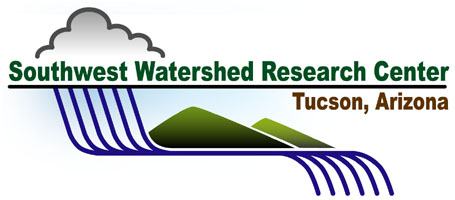| SWRC Bulletin (Summer 2009) |

|
|  | The SWRC BulletinSound Science for Water Decisions Summer 2009 |
Latest Science Results (not yet published) (click on title for more information) Woody plants modulate the temporal dynamics of soil moisture in a semi-arid mesquite savanna Very high resolution panoramic photography to improve conventional rangeland monitoring Growing season ecosystem and leaf-level gas exchange of an exotic and native semiarid bunchgrass Rangeland Hydrology and Erosion Model Soil Erosion and Runoff in Different Vegetation Patches from Semiarid Central Mexico Coarse bed material patch evolution in low-order, ephemeral channels Estimating evapotranspiration under warmer climates: Insights from a semiarid riparian system | Highlight from Recently Published Research:Recently, record drought conditions have occurred across the arid Southwest U.S. Such conditions are likely to be especially challenging for evergreen shrubs that must protect their leaves from the effects of prolonged exposure to high light and severe water deficits during these dry periods. The figure shows a unique series of ''snap-shots'' of plant function through the course of a night and a day across different ridge topographic exposures at the very end of an extreme dry period. We found that the two contrasting evergreen shrubs, the broad-leaved jojoba (Simmondisa chinensis), and the more small-leaved creosotebush (Larrea tridentata) differ dramatically in their ability to both effectively harvest and protect themselves against the effects of light throughout the day. Creosotebush, with its open canopy of small leaves, showed greater evidence of prolonged drought stress, and was not able to muster the mechanisms needed to dissipate excess light energy (i.e. low NPQ), leading to extremely low optimal photochemical efficiency (Fv/Fm) and excessively high photochemical yields (fPSII), which could lead to widespread photo-damage. Jojoba, on the other hand, seemed to hold on to its outer canopy leaves at the expense of their functional integrity (which were very similar to creosotebush), in order to protect inner-canopy leaves, which had much higher functional photochemical capacity across the different exposures, from the effects of high light under intense drought. Papers Published 1st Half 2009:Ritchie, J.R., Nearing, M.A., Rhoton, F. 2009. Sediment budgets and source determinations usng fallout Cesium-137 in a semiarid rangeland watershed, Arizona, USA. J. of Environmental Radioactivity. 100(8): 637-643 Polykov, V., Kimoto, A., Nearing, M.A., Nichols, M.H. 2009. Tracing sediment movement on semi-arid watershed using Rare Earth Elements. Soil Science Society of America. 73:1559-1565. (763 KB PDF) Kontz, N., Banninger, D., Nearing, M.A., Alewell, C. 2009. Process identification of soil erosion in steep mountain regions?. Hydrology and Earth System Sciences. 6(2):2153-2188. Wei, H., Nearing, M.A., Stone, J.J., Guertin, D.P., Spaeth, K.W., Pierson, F., Nichols, M.H., Moffett, C.A. 2009. A new Splash and Sheet Erosion Equation for Rangelands. Soil Science of America Journal. 73:1386-1392 (651 KB PDF) Moran, M.S., Hutchinson, B., Marsh, S., McClaran, M., Olsson, A. 2009. Archiving and Distributing Three Long-Term Interconnected Geospatial Data Sets. IEEE Transactions on Geoscience and Remote Sensing. 47(1): 59-71. (891 KB PDF) Hamerlynck, E.P., Huxman, T.E. 2009. Ecophysiology of two Sonoran Desert evergreen shrubs during extreme drought. Journal of Arid Environments. 73: 582-585. (202 KB PDF) Moran, M.S., Scott, R.L., Keefer, T.O., Emmerich, W.E., Hernandez, M., Nearing, G.S., Paige, G.B., Cosh, M.H., O'Neill, P.E. 2009. Partitioning evapotranspiration in semiarid grassland and shrubland ecosystems using time series of soil surface temperature. J. Ag. & Forest Meteorology. 149:59 72. (944 KB PDF) Stromberg, J., Dixon, M.D., Scott, R.L., Maddock, T., Baird, K., Tellman, B. 2009. Chapter 20: Status of the Upper San Pedro River (USA): Riparian Ecosystem. In: Ecology and Conservation of the San Pedro River. Ed. by J. C. Stromberg and B. J. Tellman. Tucson: University of Arizona Press. p. 371-387. (9 MB PDF) Richter, H., Goodrich, D.C., Browning-Aiken, A, Varady, R. 2009. Chapter 9: Integrating science and policy for water management. In: Ecology and Conservation of the San Pedro River. Ed. by J. C. Stromberg and B. J. Tellman. Tucson: University of Arizona Press. 529 p. (4.42 MB PDF) Williams, D.G., Scott, R.L. 2009. Chapter 2: Vegetation-hydrology interactions: Dynamics of riparian plant water use. In: Ecology and Conservation of the San Pedro River. Ed. by J. C. Stromberg and B. J. Tellman. Tucson: University of Arizona Press. Pp.37-56. (2.79 MB PDF) Our full publication list is available at: Future Science Events:Click here for information about workshops, including an upcoming workshop on buffelgrass and the 6 thAnnual RISE Symposium at University of Arizona. Rainfall Report:   WGEW and SRER data can be downloaded from the web site at http://www.tucson.ars.ag.gov/dap Awards:SWRC Scientists continue to win national awards and grants, including a research paper award for Mark Nearing and NASA grants for Phil Heilman and Susan Moran. Click here for more information. Staff News:Click here for SWRC news, including new hires and visitors, three graduations (congratulations!), technology transfer and workshop reports.SWRC Bulletin:Contact the SWRC Research Leader, Dr. Mark Nearing at 520-670-6381 x152 or mark.nearing@ars.usda.gov. Mailing address is USDA ARS SWRC, 2000 E. Allen Rd., Tucson, AZ 85719 and web address is http://www.tucson.ars.ag.gov. The SWRC Bulletin is online at /News/News.htm?modecode=53-42-45-00.SWRC Mission:To develop knowledge and technology to conserve water and soil in semi-arid lands. |



